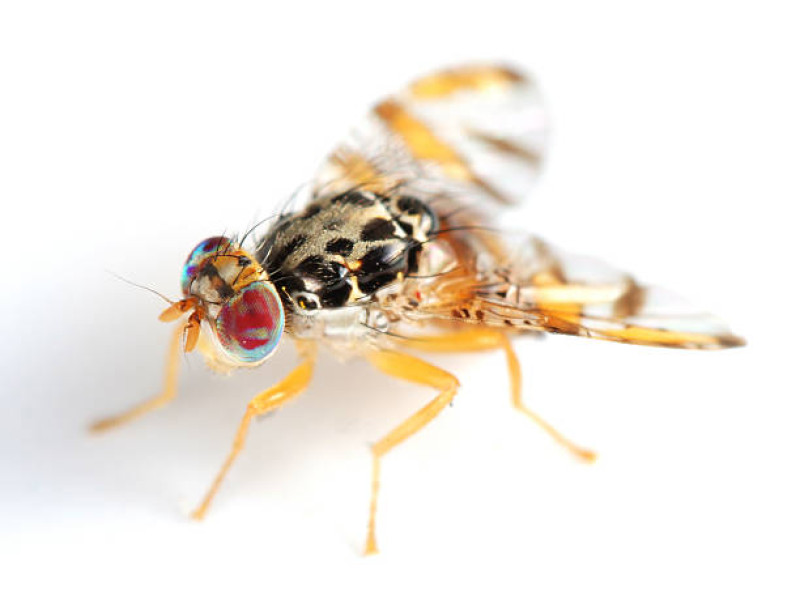What you need to know about the Mediterranean fruit fly detected in the eastern part of the country

Santo Domingo—Ceratitis capitata, known as the Mediterranean fruit fly, is considered one of the greatest enemies of agriculture. It attacks more than 200 fruit species, such as mango, avocado, guava, and most citrus fruits, even reaching vegetables such as eggplant.
The Ministry of Agriculture detected an outbreak in Los Corales, Punta Cana, La Altagracia province. So, it activated an emergency protocol in the detection perimeter through the National Program for the Surveillance and Control of Fruit Flies.
But what is known about this agricultural pest?
The Mediterranean fly is an insect with a wide geographical distribution, coming from sub-Saharan Africa, from where it has spread to other temperate, subtropical, and tropical zones of the two hemispheres, explains agronomist Fernándo García Marí.
BIO-ECOLOGICAL CYCLE
The specialist García Marí explains that the females of the Mediterranean fly lay eggs by piercing the skin of the fruits, which, after two or three days, transform into larvae or worms.
The larvae hatch inside the fruit and feed on the pulp, causing it to rot.
“This development is completed between seven and ten days, when they leave the fruit, fall to the ground, bury themselves and transform into pupae or buds,” according to the professor of Agroforestry Ecosystems in Valencia.
To employ, the larva stops moving, reaching total immobility. Then, in that state, “a metamorphosis begins that culminates in about ten days if the temperature remains uniform at 22 degrees Celsius.”
The expert explains that the adult emerges from the pupa and takes two or three days to reach sexual maturity. Once this is achieved, copulation occurs.
“Four or five days after mating, the female is in a position to lay eggs. Egg-to-adult development can occur in less than three weeks or last up to three months or more when unfavorable conditions are present,” he says.
The adult lives quite a long time, from one to two months; in that time, the female can lay up to 300 eggs in groups of four to eight.
“With these parameters, the multiplication capacity of the insect is 0.14 females per female per day, which means that the number of insects doubles every five days in the absence of mortality factors,” according to the document “The Mediterranean Fly,” extracted from the book by agronomist García Marí, entitled “Agricultural Pests.”
EXTERNAL APPEARANCE
The document describes that adults measure 15 millimeters, with a shiny black thorax and characteristic white spots. The abdomen is brown with light bands. It has two membranous wings, with three yellow-orange bands forming the typical wing pattern of the π symbol (Greek letter Pi).
The eggs are creamy-white, elongated, with tapered ends less than two millimeters long. The larvae are 3 to 6 mm long and yellowish-white in color. They are muciform (broad caudally, gradually thinning towards the head). The larvae hatch inside the fruit and feed on it. They go through three larval stages until they reach the next pupal stage. The pupae take on the appearance of brownish-brown capsules with 11 segments and are 3 to 5 millimeters long.
DAMAGE
Agronomist García Marí points out that the feeding activity of the larvae causes fruit to fall due to the decomposition of the pulp, which is also affected by the development of pathogens (mainly fungi of the genus Penicillium) that enter through the holes of the laying bites.
In citrus fruits, even if the larvae die before completing their development, the fruit’s rind is affected, and yellowish spots or halos appear around the point of bite, depreciating the fruit.
In addition, the marketing of fruits containing developing eggs or larvae often allows the evolution of insects during transport, which causes losses at the destination due to the rapid rotting of the fruit.
In the case of citrus, if the chopped fruit is not detected in the field, the larvae develop in the de-greening chambers, which can affect adjacent fruits that have not been chopped.

















Now that you broke down all these facts for us ,what’s the remedy for these problem that can cause horrible consequences for our agriculture …